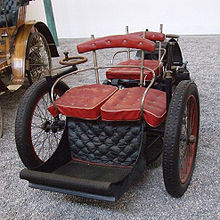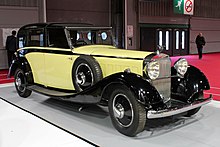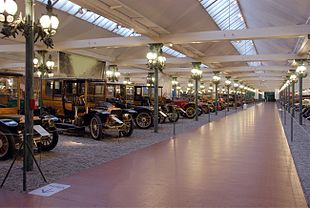Cité de l'Automobile
The Cité de l'Automobile - Musée National - Collection Schlumpf (City of the Automobile, National Museum, Collection Schlumpf) is the largest automobile museum in the world with an exhibition area of 25,000 m², 17,000 of which are in a single huge hall . It is located in Mulhouse in Alsace in France .
The core of the inventory are 400 vintage cars, mostly from the early phase of the automobile era up to the 1930s, which were collected by the brothers Fritz and Hans Schlumpf , formerly wealthy textile manufacturers who, among other things, drove their company to ruin through their passion for collecting. Another 150 automobiles, some of which are in a desolate condition, are located outside the museum.
history
In 1957 the brothers Fritz and Hans Schlumpf took over the textile factory HKD (Heilmann, Koechlin & Desaulles), a wool spinning mill in Mulhouse. The passionate automobile collector Fritz Schlumpf secretly bought a large number of classic automobiles between 1961 and 1963, using numerous front men who were to buy the automobiles in France and neighboring countries as well as in the United States. Only a few people were allowed to enter the factory's warehouses in which the vintage cars were housed.
In May 1965 an article appeared in the magazine L'Alsace , which made the existence of the previously secret large automobile collection known to the public. Fritz Schlumpf now decided to present his unique collection to the public. In 1966, long-term renovations began in the warehouse of the textile factory. Partitions were removed so that the future Schlumpf Museum could be accommodated in a single exhibition hall with an enormous floor area of 17,000 m². In addition, the automobiles were restored at great expense. The collection continued to grow until 1976, when it comprised over a hundred Bugattis and numerous vehicles from other brands.
From 1966 to 1976 Fritz Schlumpf invested around 12 million francs in his museum project. This costly passion has put an excessive strain on business assets. At the same time the textile industry got into a crisis. On June 28, 1976, the workers went on strike. When the insolvency became apparent, Fritz and Hans Schlumpf tried to sell their company for the symbolic price of 1 franc, but no offers to buy were received. The brothers then fled to Basel . The more than 2000 employees had to be made unemployed.
In 1977 a complicated legal battle began between the Schlumpf brothers and their creditors. In March 1977 the camps were occupied by the unions. The occupiers made the collection accessible to the public for the first time. Several courts ruled that the collection should be sold in order to satisfy the claims of the creditors. However, the collection could be bought back by an interest group at a price of 44 million francs and thus preserved in its entirety. The supporting association of the museum, which made this sum available in 1981, includes the city of Mulhouse , the Council of the Haut-Rhin department , the regional council of the Alsace region (part of the Grand Est region since 2015 ), the Mulhouse Chamber of Commerce and Industry , Panhard & Levassor (part of the PSA group ), the Automobile Club de France and the Paris Motor Show Committee (Mondial de l'Automobile). On July 10, 1982, the Musée national de l'Automobile was opened.
Operator of the museum
The association responsible for running the museum includes the City of Mulhouse, the Haut-Rhin Department, the Department's Tourism Association, the Mulhouse Tourism Office, the Mulhouse Museum of Commerce and Technology Association (CESTIM) and the Mulhouse Economic and Social Progress Action Committee .
Exhibits








One focus of the exhibition are 87 Bugatti vehicles . These include two of a total of six still existing Bugatti Royale (Type 41) as well as the reconstruction of another example (a Bugatti of this type achieved a purchase price of around eight million US dollars at auction in 1991).
In addition to the Bugatti, the museum shows very old models from other important brands, such as (as of March 2011):
- 1 eagle
- 1 AFG Grégoire
- 1 Alart
- 7 Alfa Romeo
- 1 Alpine
- 4 Amilcar
- 2 doctors
- 1 aster
- 1 Audi
- 3 ballot
- 1 bardon
- 2 barré
- 1 Baudier
- 1 Benetton
- 5 Bentley
- 7 Benz
- 1 Berliet
- 1 BNC
- 1 Brazilian
- 1 charron
- 1 Cisitalia
- 7 Citroën
- 2 Clément-Bayard
- 1 Clément-De Dion
- 1 Clément-Panhard
- 1 Corre-La Licorne
- 3 Daimler
- 4 Darracq
- 1 Decauville
- 1 De Dietrich
- 16 De Dion-Bouton
- 2 Delage
- 4 Delahaye
- 2 Delaunay-Belleville
- 1 Dufaux
- 1 esculape
- 1 Facel Vega
- 2 Farman
- 12 Ferrari
- 3 Fiat
- 1 Ford
- 1 fouillaron
- 3 Gardner-Serpollet
- 3 Georges Richard
- 1 gladiator
- 11 Gordini
- 1 Grégoire
- 2 Grégoire
- 1 Hermes Simplex
- 7 Hispano-Suiza
- 3 Listen
- 1 Hotchkiss Grégoire
- 1 hurtu
- 2 Isotta Fraschini
- 1 Jacquot steam car
- 1 Jordan
- 3 Lancia
- 1 Le Gui
- 3 Le Zèbre
- 1 Léon Bollée
- 1 ligier
- 4 Lion-Peugeot
- 2 Lorraine-Dietrich
- 4 lotus
- 1 MAF
- 8 Maserati
- 1 Mathis
- 1 Masons Union
- 2 Maybach
- 1 McLaren
- 1 Menier
- 5 Mercedes
- 1 Mercedes-Benz
- 1 Minerva
- 1 Monet and Goyon
- 2 mors
- 1 OM
- 5 Panhard
- 12 Panhard & Levassor
- 19 Peugeot
- 1 Philos
- 1 pic-pic
- 3 piccolo
- 2 pilain
- 5 Porsche
- 18 Renault
- 1 Rhéda
- 1 Rochet cutter
- 10 Rolls-Royce
- 1 saga
- 1 Salmson
- 1 Scott
- 1 Sénéchal
- 4 simca
- 1 Sizaire-Naudin
- 1 Soncin
- 1 pp
- 1 Steyr
- 2 Talbot-Lago
- 1 Trabant
- 1 tracta
- 1 Vaillante
- 1 Valentine
- 1 violet bogey
- 2 Voisin
- 1 Williams
- 1 Zedel
In the museum's depot there is also a Mercedes-Benz “Silver Arrow” type W 154 II (1939) , for which EUR 17 million and then even 30 million EUR were offered, as well as No. 2 of 2 of the Bugatti type 251 . However, since the collection, including the vehicles that are still in the depot, are part of the French cultural heritage, they are not for sale.
literature
- Halwart Schrader (Ed.): The automobiles of the Schlumpf brothers - A documentation. Schrader, Munich 1977.
Web links
- Official website of the museum
- Information page about the Schlumpf Collection
- Automobile - Any sum . In: Der Spiegel 44/1977 (PDF)
Individual evidence
- ↑ Cité de l'Automobile: The history of the museum ( Memento des Originals of March 29, 2016 in the Internet Archive ) Info: The archive link was inserted automatically and has not yet been checked. Please check the original and archive link according to the instructions and then remove this notice. citedelautomobile.com
- ^ A b Thomas Wirth: Oldtimer exhibition in Kassel: Sleeping beauties Süddeutsche Zeitung, April 30, 2013
Coordinates: 47 ° 45 ′ 39 ″ N , 7 ° 19 ′ 43 ″ E




